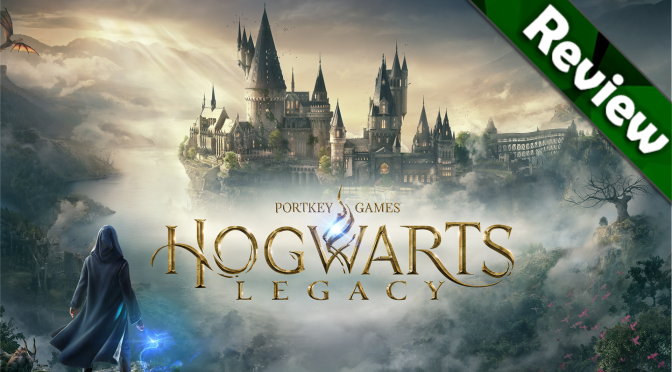I’ll be honest here, I’ve never had much of an interest in the Harry Potter series. I didn’t read the books, and in fact, I hadn’t watched most of the movies until recently (and that was to specifically prepare for the launch of the game, so I can write a more extensive review).
I also had a healthy dose of skepticism, especially given Avalanche Software’s previous record. This team has never done anything even close to this scale, so I was a bit cautious about this game.
So, after finishing the campaign, along with a large number of side activities that took me around 65 hours in total, here are my thoughts.

Story
Hogwarts Legacy is set in the late 1800’s, quite some time before the movies take place. You play as a 5th year student who holds the key to an ancient secret that threatens the wizarding world. There are several story arcs that run alongside the main one as you make your way through the campaign where you’ll be dealing with goblins, poachers and dark wizards, all revolving around different characters. It keeps things varied and interesting. As usual I’m not going into any details about the story here, but suffice to say, I enjoyed it. The various arcs, while not the most original, were entertaining enough to carry me all the way through to the end without me losing interest or momentum.
Visuals & Audio
Visually, Hogwarts Legacy is a treat. The amount of detail they’ve put into creating Hogwarts itself is especially impressive. Hogsmeade and the world at large, while not at the level of Hogwarts, are also nice looking. Avalanche has done a fantastic job of recreating the atmosphere and locations portrayed in the films, something I hadn’t expected from them.
The voice acting was also pretty decent, as was the lip-syncing for the most part. Okay okay, there were some issues here and there, but never enough to distract from the experience. I also found the music to be particularly fitting with its highs and lows, working well with the theme and visuals, and I really enjoyed the various tracks throughout my time with the game.
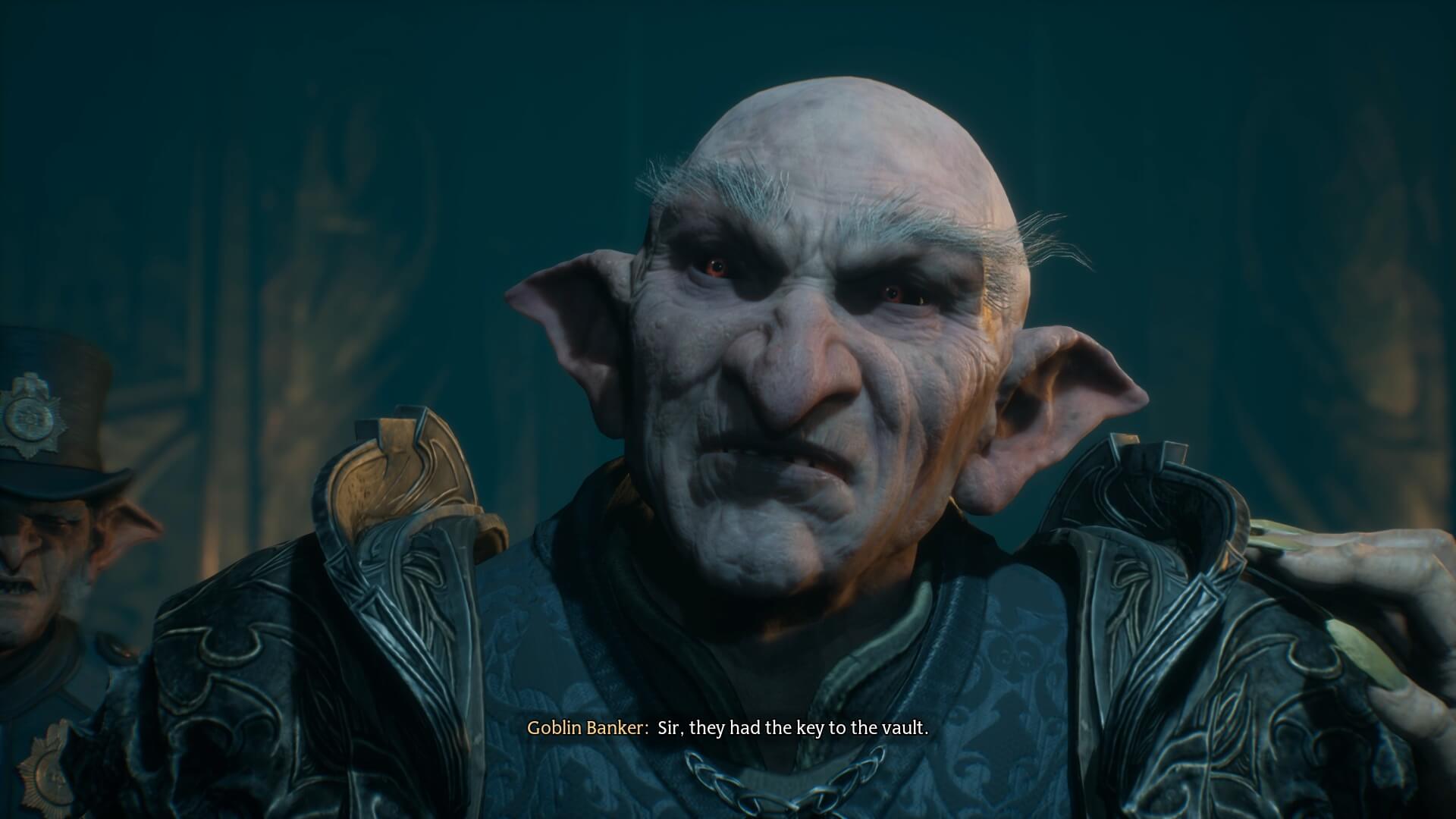
Gameplay
Hogwarts Legacy is an open-world RPG, or perhaps RPG “lite” if you like. Formulaically similar to what one would find in most typical open-world games these days, especially regarding exploration and itemization, but it’s all rather superficial as far as depth goes. A main questline, sidequests scattered throughout, and a large world map full of icons to chase.
The game starts off relatively slowly, with lots of cutscenes and dialogue, and gradually introduces the mechanics over the first hours. You’ll pick your house at some point, which doesn’t really change much. All you’ll get are a few specific quests, some other dialogue options, as well as a different common room and a specific robe.
You’ll be learning new combat and utility spells at various points throughout the story via assignments, unlocking the Room of Requirement which allows you to grow herbs (potion ingredients), brew potions, identify and upgrade gear and also keep wild beasts, which provide you with materials to upgrade said gear. I’ll talk a little more about the Room of Requirement a bit later. At some point in the story, you will also unlock the ability to fly around on a broom which can subsequently be upgraded. Going to classes and doing assignments are cool activities, but they are not mandatory. This isn’t like Rockstar’s Bully where you have a class schedule to follow.
Aside from combat, there are a number of puzzles, a few broom races, an Acio ball minigame, treasure caves, and a ton load of other collectables/challenges to find which will reward you with cosmetics for your gear, your broom, furnishings for your Room of Requirement, treasure and traits that give you better defense against specific enemy types.
You’ll be running around casting Revelio a lot as well which highlights hidden items. And while the X-ray vision doesn’t make any sense in many games, in Hogwarts Legacy it’s at least somewhat believable due to its world and setting.
Doing activities and combat net you XP, which levels you up and awards talent points that can be put into one of the available talent trees (Spells, Dark Arts, Core, Stealth and Room of Requirement). I personally found the stealth and Room of Requirement trees to be the least interesting of them all, and once I hit level 40 (max) I had almost all the skills that I wanted. Also, there seemed to be zero consequences to using Dark arts in the game, and the related tree, at least in my opinion, had by far the most powerful abilities in it.
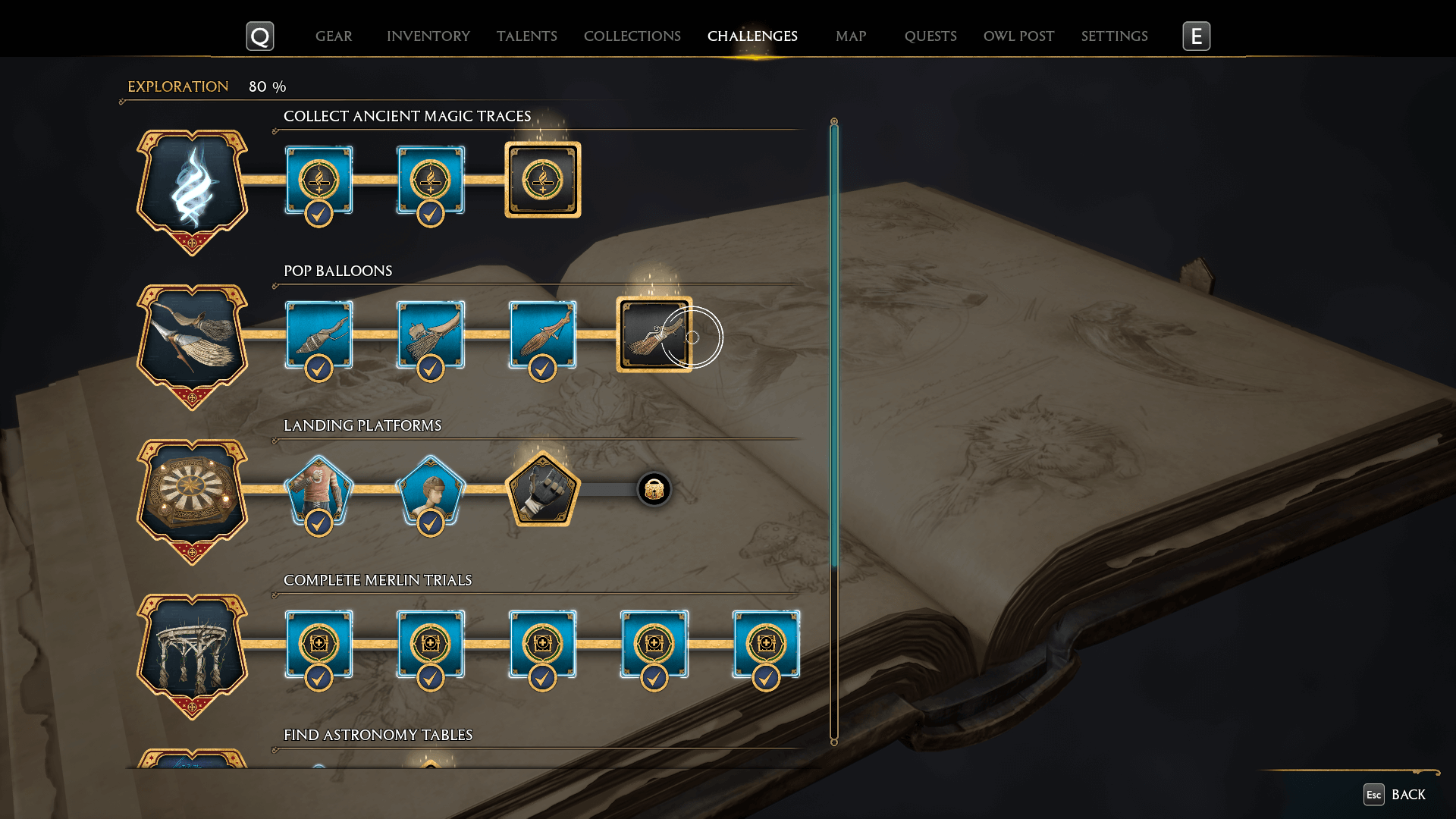
Combat
The combat itself is not particularly deep, but I found it to be both enjoyable and engaging. It has a great sense of weight and impact, although a hardcore difficulty mode would have been a nice welcome for those of us who wanted a more challenging experience.
You’ll fight a variety of enemies, and most of them have some kind of weakness that you can use to your advantage. For example, a Dugbog tongue attack can be interrupted by casting Leviosa and by casting Diffindo you can kill it instantly. Another example. When a spider begins to burrow, it can instantly be killed by casting Leviosa. Additionally, most humanoid melee enemies can have their weapons taken away with Expelliarmus and thrown back at them. All of these weaknesses are outlined in the enemy description cards you find when encountering an enemy for the first time, so it pays to read through each of these so you are prepared for each encounter.
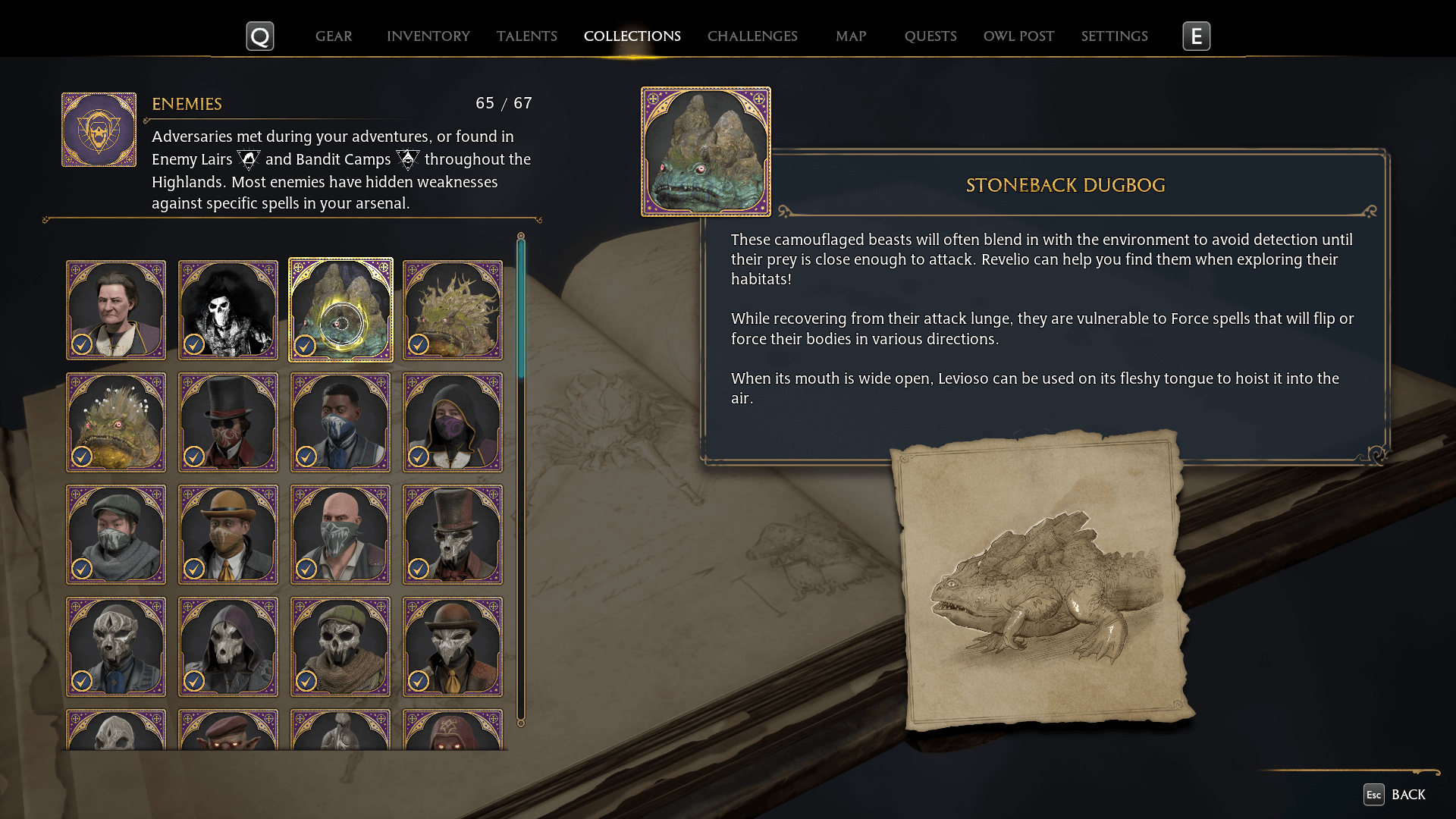
Humans and goblins will also shield themselves with Protego, a shield in one of three colors (yellow, red, purple) that will just absorb any damage directed at them. You’ll need to break these shields first by casting a corresponding colored spell or using ancient magic to throw an object at them to break it before actually being able to do any damage.
As a player, you are able to block normal attacks by pressing or holding Q to cast Protego. Holding Q not only blocks an attack but will also Stupefy whatever enemy you currently have targeted. Finally, you are also able to dodge roll, something that will help you avoid unblockable attacks. The dodge can be upgraded to become a dash allowing you to travel further when evading attacks or moving around the combat area quickly. Blockable and unblockable enemy attacks are telegraphed as an orange and red ring, respectively, around your character’s head, so it’s easy to react to your enemy’s attacks.
Having to juggle spell casting, dodging, blocking, breaking shields, and disarming enemies kept encounters interesting. Some encounters were a little more challenging than others, but as I said earlier, none of them were actually difficult per se, especially once I understood the mechanics. There were no instances where things were unfair or where I felt the game was using cheap tactics.
Some areas can be approached stealthily, and some missions require it, but it’s a small part of the game. You can of course sneak into bandit camps and take them out one at a time as well if that’s your preferred playstyle though.
Aside from the overall lack of difficulty, I wish there was more enemy variety and that the open world had more combat encounters scattered throughout. If I had to leverage a larger complaint about combat, it would be that the flow is hindered by the UI and lack of available hotkeys for spellcasting which I will talk about later.
There are a few plants you can grow that can also be used in combat. I barely used these in my playthrough since casting spells did a perfect job, and I never found that I needed to supplement my combat with the use of these plants in order to manage it, outside of needing to use them to complete assignments to unlock new spells.
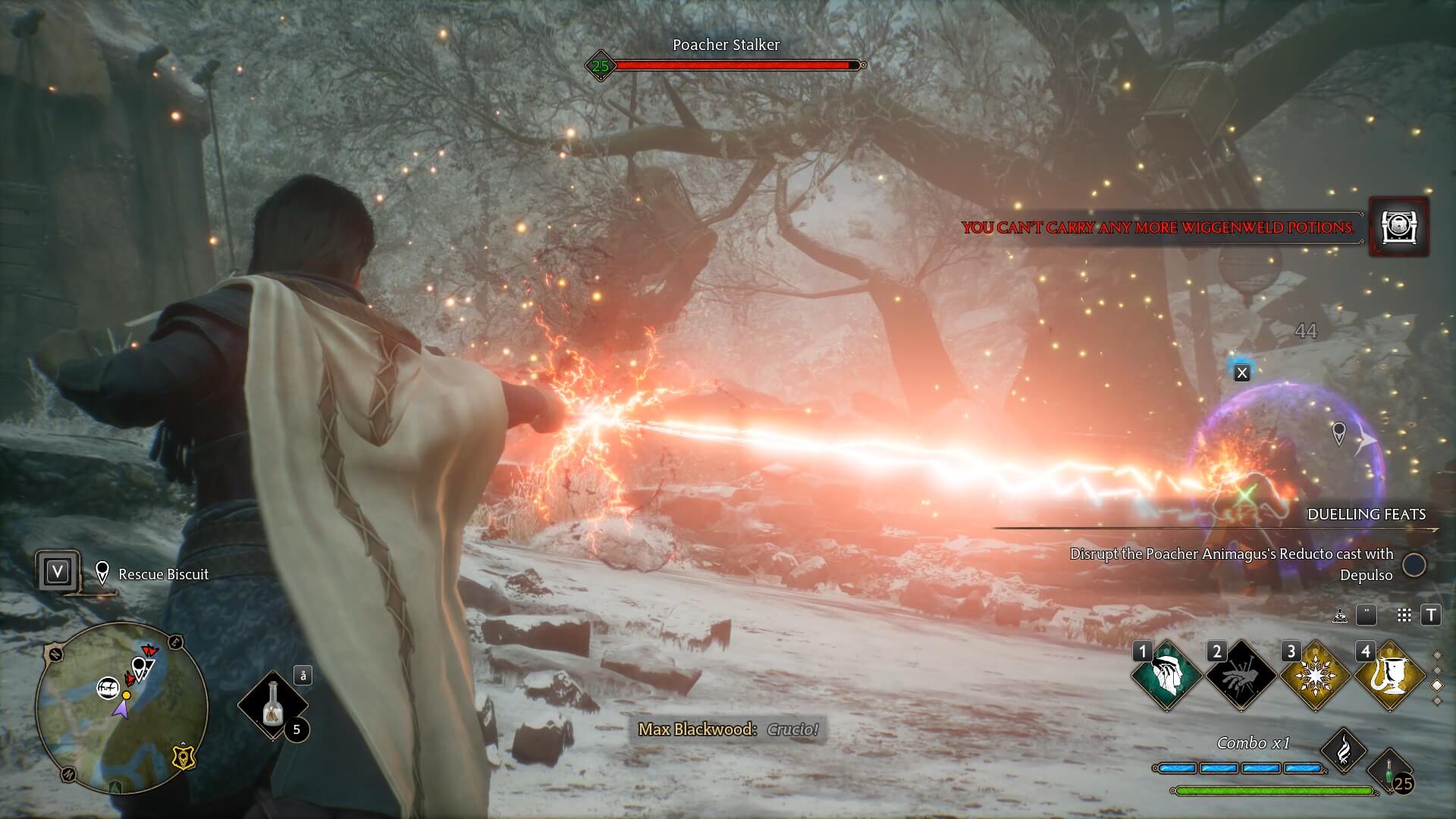
Puzzles
There are a number of puzzles in the game, found in many of the campaign quests, side missions and open-world sections. The puzzles are all pretty easy, but your character seems to enjoy blurting out hints constantly, not giving you any time to actually figure stuff out. I don’t feel the need or want to be handheld, so as a result I found it particularly annoying.
Later in the game, you’ll learn Alohamora, the lockpicking spell. There are 3 levels to the spell allowing you to open level 3 locks eventually. The mini-game for this gets very repetitive after the first few times, and you will be forced to do this for every single lock in the game. Every lock no matter the level is the same minigame, it doesn’t get harder or more complex either. I don’t see why they didn’t just allow the mini-game to be skipped entirely or at least allow you to auto-pick any locks that are a level below your current level of Alohamora. At least there is a mod that fixes this.
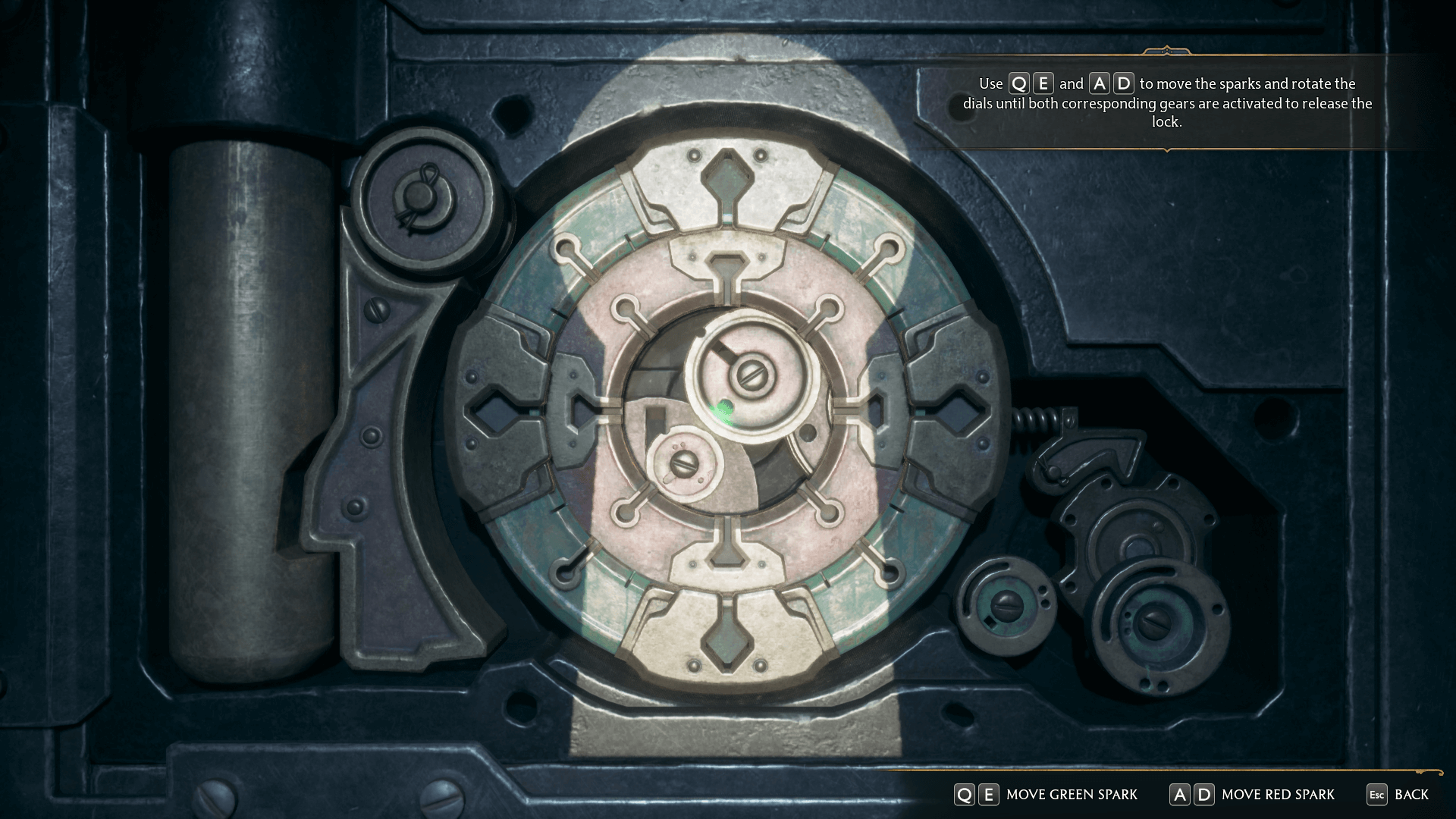
Exploration
The map is divided into 3 parts. Hogwarts, Hogsmeade, and the open-world area.
Exploring Hogwarts, at least for the first several hours, remained interesting for me. There was a ton of detail and plenty of secrets to find in the large and detailed location which kept me busy, digging into every nook and cranny to find all the treasure and various other secrets scattered about.
Hogsmeade was well made, but less interesting to explore. Aside from the few stores you’ll be visiting, the rest of the town is made up of houses that can be explored once you get the Alohamora spell to pick the locks. That’s really about it. You’ll find a chest or two, maybe a collectable, and perhaps some coin.
The open world is probably the worst offender here. At first, it looks awesome, vast, richly detailed, and something you’d want to explore. However, I soon realized that it was relatively empty, and exploring beyond marked icons on the world map served no real purpose. There are enemies scattered about here and there but not a great deal of them.
There are also no dynamic open-world events that you happen across while you travel. As a result, it wasn’t long before I just made sure to unlock fast travel points so that I could fast travel around the map to get quests or whatever else I needed done.
There are a number of small towns around the map, smaller versions of Hogsmeade essentially, and are just locations with houses that can be looted if you have the appropriate level of Alohamora, or a place where vendors and quest givers can be found. Something that struck me as odd is that people never seemed to care if I went into their houses and took all their stuff. No comments or even a reaction.
Other than that there are bandit camps, Merlin trials (puzzles with a few varieties that when done will eventually unlock more inventory space), and treasure caves which unfortunately are mostly copy pasted, so you’ll be repeating the “same” layout quite frequently and a few other POIs to explore.
I think that so much more could have been done with the open world in Hogwarts Legacy. While it’s not inherently bad, it’s just a little uninspired.
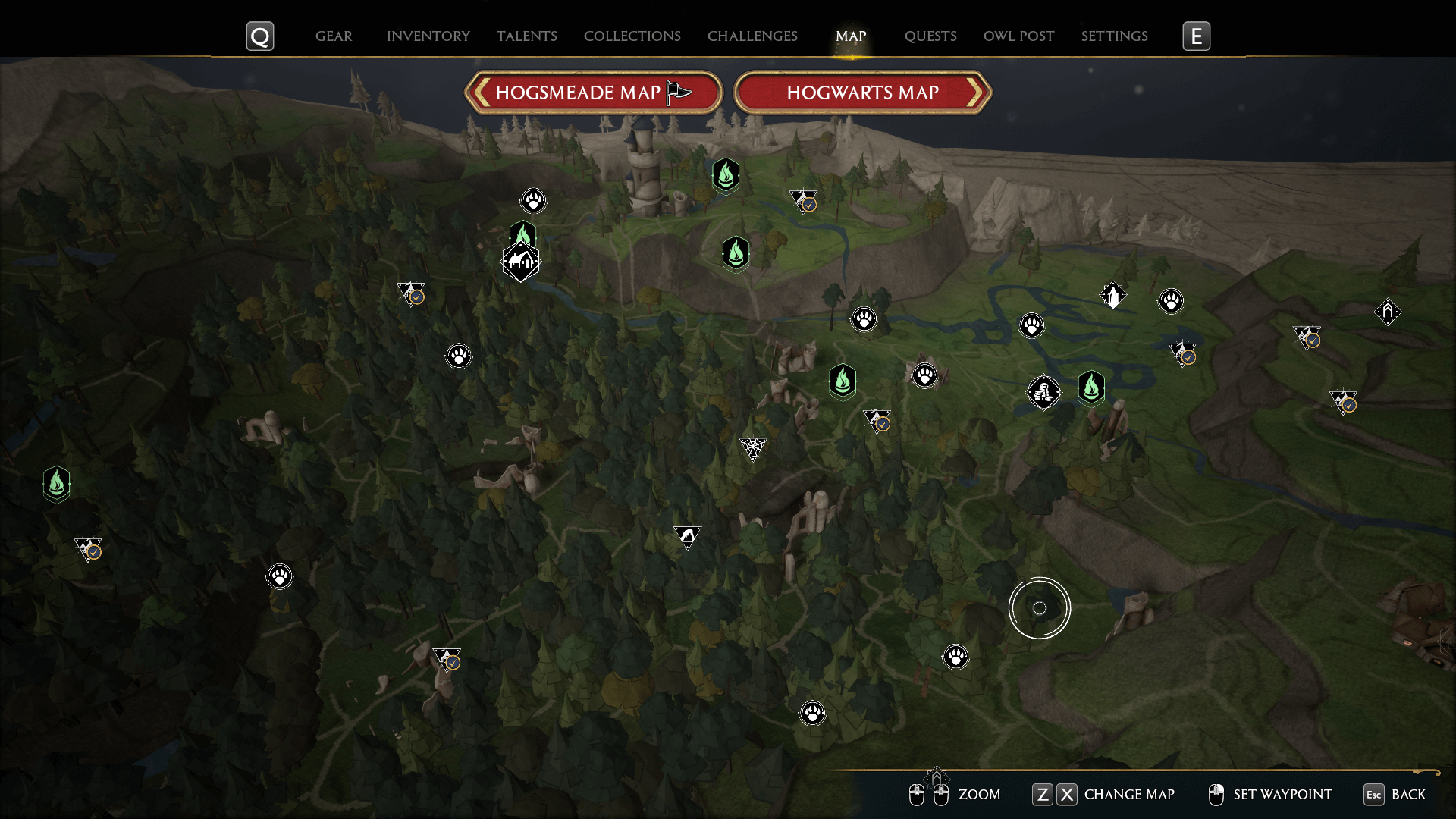
UI
The UI is probably the worst aspect of the game. It’s clearly designed for gamepads. Most of it is passable, but the spell menu is just horrid. You have 4 slots in each row (accessed by the numbers 1-4). You can unlock an additional 3 rows via talent points giving you a total of 16 spell slots.
The problem is that even with all the slots unlocked you won’t have enough space to equip all the spells you need to use regularly. You’ll have to constantly switch out various utility spells depending on what you want to do. The issue is made worse in combat. You’ll need to constantly cycle between these spell bars to access various spells. It’s cumbersome. On PCs that have access to an entire keyboard and also mice that can have upwards of 17 buttons, why limit the user to 4 slots that need to be cycled? At least allow all 16 slots to be hotkeyed, not just the 4 of them. MMOs have existed with this functionality for decades.
Most of the icons and overlays can be disabled on the minimap. I chose to do it for the first several hours of my playthrough, since it created a greater sense of exploration in Hogwarts. However, there is no such option for the world map. Every single icon is always displayed once you go near a POI in the world. What ends up happening is that the world map gets cluttered with icons throughout your playthrough and, at least for me, this entirely removes any incentive to explore the world organically and results in an icon-chasing game loop.
Finally, the loot inventory menu is also rather clunky. You’ll be collecting a ton of gear during the game, a lot of which is useless and will need to be sold. Towards mid-game when you have a larger inventory full of gear that there is no way to sell it easily, you are required to sell one at a time by clicking and holding your mouse button on each one for 2 seconds or something. You are required to do this quite frequently, otherwise, you won’t be able to pick up more loot. I don’t understand why developers don’t add QoL features like filters and sell all options.
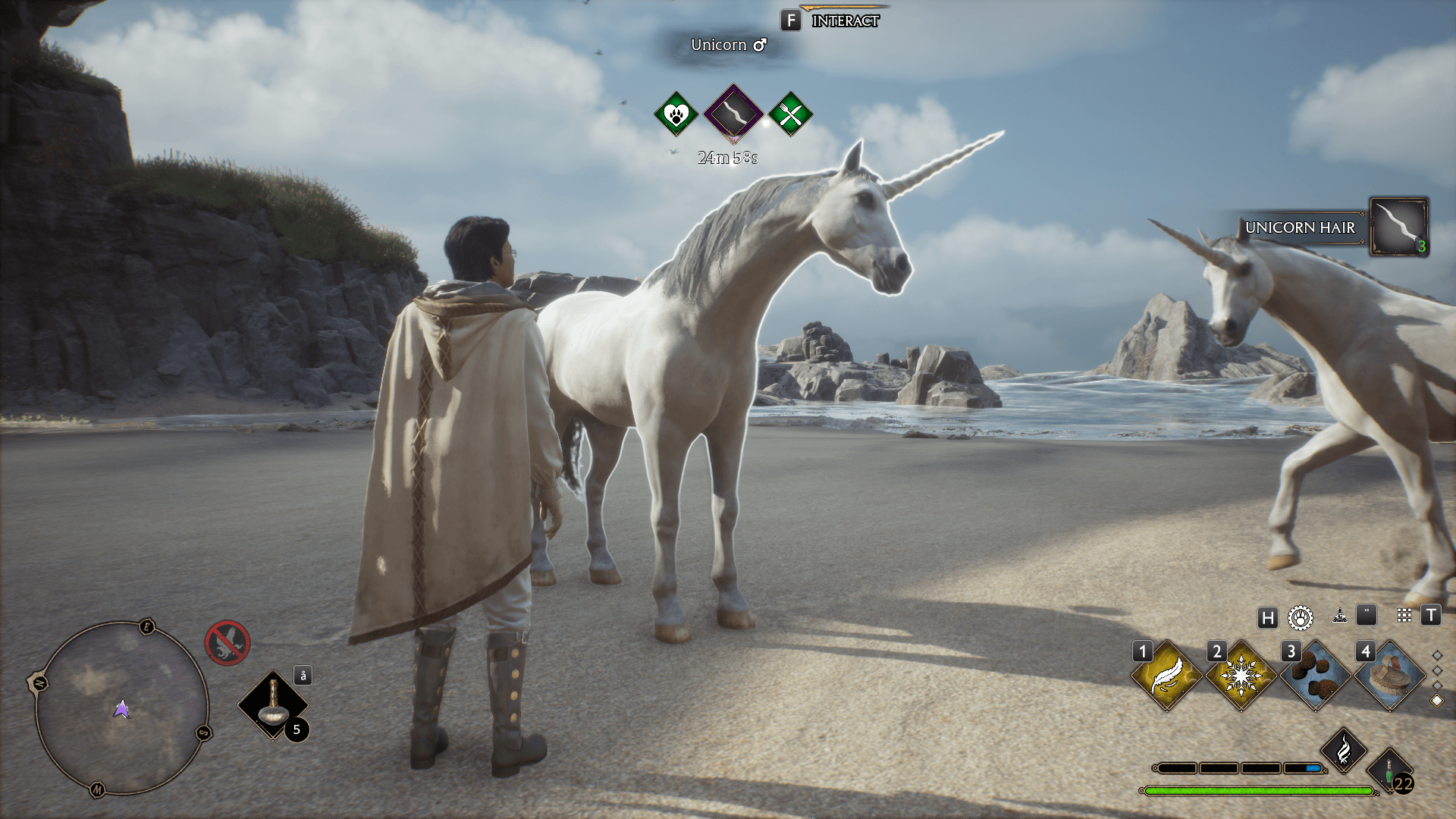
Itemization
Itemization is arguably the weakest system in Hogwarts Legacy. You’ll be finding and replacing your gear so frequently that finding new gear loses its value. A lot of the time a new piece of basic green gear will be better than the legendary orange gear you collected earlier.
For the first part of the game, at least until you’ve unlocked the loom, you’ll pick whatever gear has the highest offense regardless of color. Once you get the loom it allows you to upgrade your gear so the offense/defense stat is higher and you can also put in a trait. Better gear can hold a higher level trait. Higher traits have better bonuses. However, the gear didn’t really have much of an impact early in the game. And, once you can fully upgrade your legendary gear, it won’t really feel that necessary as you will likely be steamrolling encounters anyway. The stats are just not very meaningful. The same can be said for the various traits in the game (think gems that enhance spells or defense against certain enemies). Admittedly, while some of them are pretty useful, many of them are not just not worth using due to the game just not being hard enough to warrant it.
Practically though, gear seemed like more of a way to unlock new cosmetic options. At this point another issue manifests itself. I found most of the cosmetic options made my character look like a clown, but I suppose that will boil down to personal taste. It would have been nice to be able to set up a cosmetic template, or for the game to just keep my current look and just swap out the gear. As it stands at the moment every time you switch out a piece of gear you’ll need to reassign what visual appearance you want it to have and there are 6 gear slots that you’ll be doing this with incredibly frequently. It’s a lot of unnecessary busywork.
You can also customize the look of your broom and will find a variety of wand handle cosmetics that you can choose from as well, but they have no impact other than the visuals.
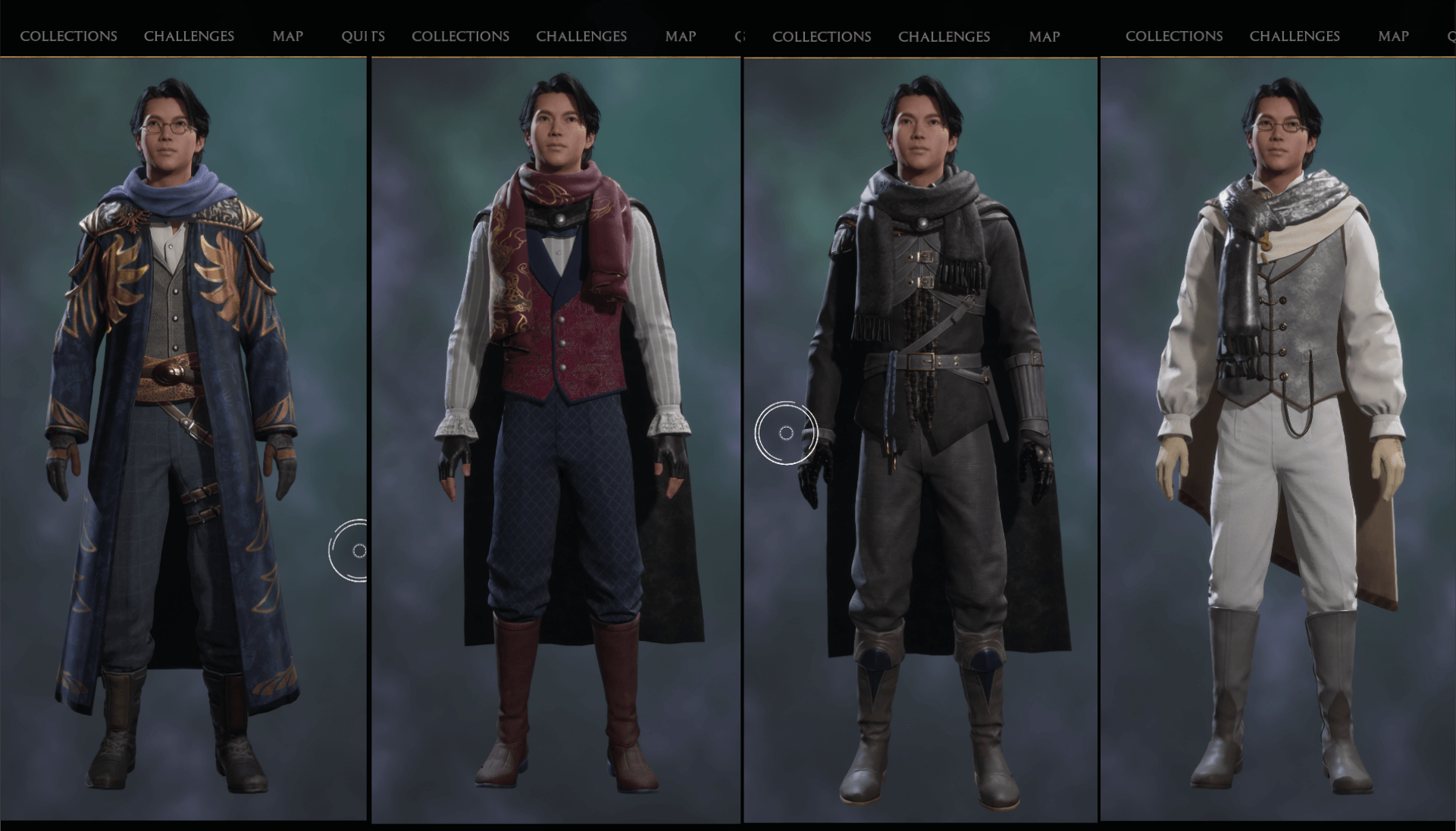
Room of Requirement
The room of requirement unlocks during the storyline and is a place where you can grow herbs, brew potions and collect wild beasts as I mentioned earlier. I don’t want to spoil too much here, but you can decorate it with all manner of furnishings and styles which you will either find or can purchase, which unfortunately serves no purpose other than “it looks” cool. (aside from the items that actually craft/grow/create stuff of course).
To get beasts you’ll need to capture them at certain locations/times of day on the world map and will need to have unlocked the Nab-Sack. Different beasts provide different materials. There’s a simple mini-game in order to do so. Rarer beasts just have a longer version of the minigame. Each vivarium can only house a certain number of species, and you can sell excess beasts in your Nab-Sack if you don’t want to keep them. At the risk of sounding like a poacher, the capture-and-sell strategy is actually not a bad way to earn some decent income if you’re short on cash.
Growing plants, brewing potions, and harvesting materials from wild beasts are all on a real-time cooldown. For example, to harvest materials from a beast you’ll need to feed and brush them, once that’s done you collect the material after which there is a 25-minute cooldown until you can do it again. A similar system exists for growing plants, but it’s much shorter. You will eventually have more than you need for all of these ingredients. You can have animals breed as well, but the young ones never actually grow into adults, which is a little odd, but they still yield the same amount of materials when fed, etc.
As with every other system in the game, it appears like it has a lot of depth at first until you realize it doesn’t. Grow plants to make potions, feed beasts to get materials to upgrade your gear. That’s only what you have to do, and you will have more potions and upgrade materials than really need.
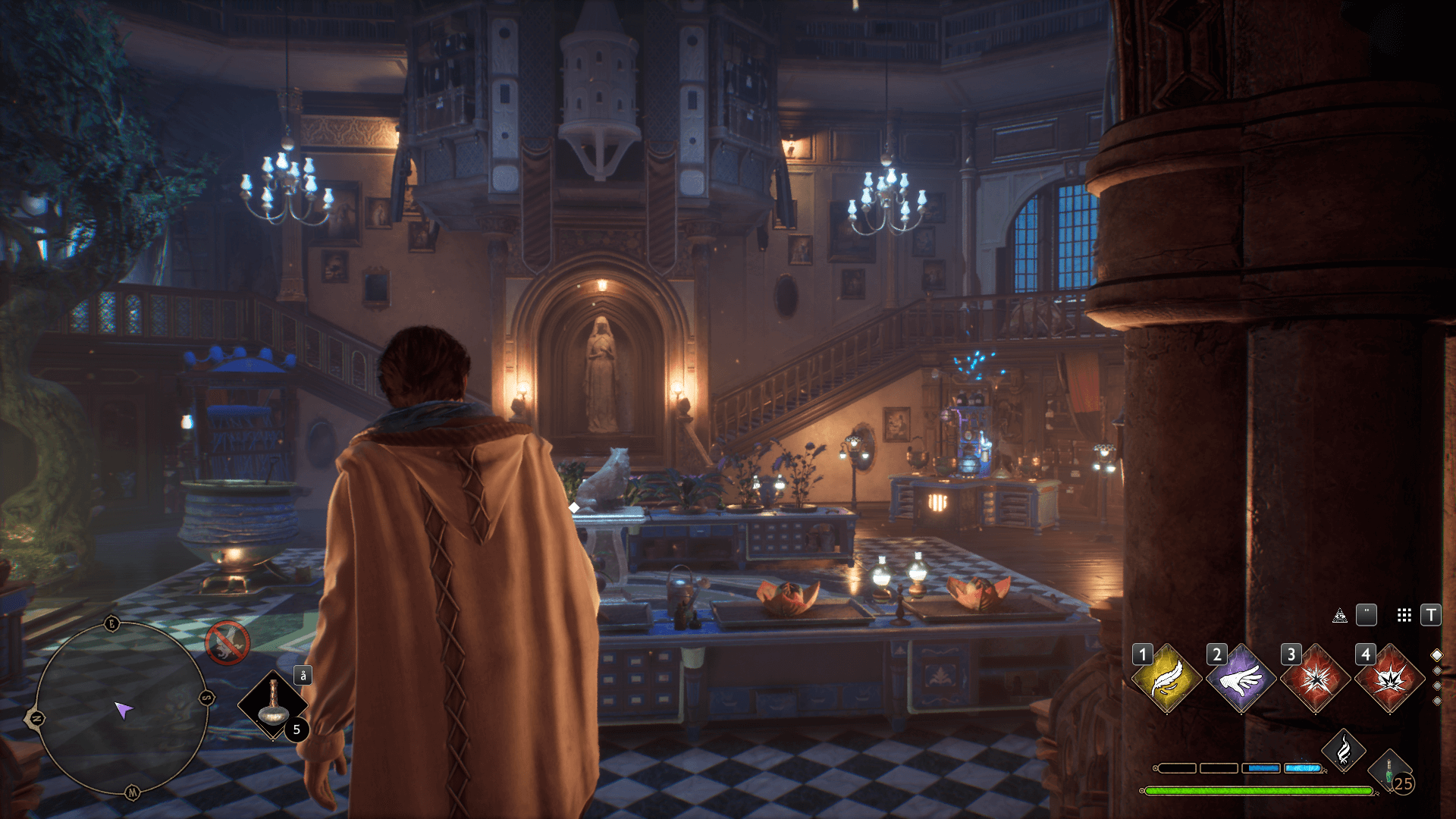
Issues
At launch, the game suffered from all manner of performance and stutter issues for a lot of people. I was fortunate though, on my PC it was smooth all the way through, minus a few minor loading stutters. On an older system that I tested it on (which met the recommended requirements), it was basically unplayable with constant 2-4 second stutters. Upgrading to 32GB of RAM made the game playable, but there were still some stutters every now and then. These issues have mostly been fixed now and the game is more playable on that system, but there are still occasional frame rate issues. I also believe that raytracing still suffers from some problems.
As far as bugs go, I had 1 instance where I needed to reload a save because after diving underwater for some gear my character could not resurface. I think the deep took him. There were also a few times where there were lighting and graphical glitches, NPCS walking into objects and getting stuck, and loot stuck behind other items making them impossible to collect. These are the main ones that come to mind. I had no crashes or majorly severe bugs that really hindered my experience at all.
Conclusion
If one were to remove the Harry Potter-themed coat of paint, Hogwarts Legacy would be a pretty standard open-world game that doesn’t venture to try anything particularly new. However, while the individual parts of Hogwarts Legacy don’t stand out as deep or particularly groundbreaking, this is one of those cases where I actually found the sum of its parts to be far more enjoyable than I would ever have expected it to be. The game also supports mods, of which there are already plenty which is a great start.
If I do have another criticism, it’s that it’s not very repayable. What I mean by that is a second playthrough would not be all that different if that is something you are expecting. There are little to no changes based on the choices you make overall, and even trying new builds wouldn’t offer a significantly different experience. That said, I’ll likely revisit it several months from now, unless there is some new content before that.
If you are looking for a relaxing and enjoyable open-world game to sink your teeth into, Hogwarts Legacy will likely scratch that itch. Coming from a non-Harry Potter fan, I think it’s actually a competent and well-made game, has a decent amount of content, and is definitely worth playing if you haven’t already. Avalanche Software has surprised me, and I’m excited to see what they do next.
![]()
- Visuals
- Impressive recreation of the the Harry Potter universe
- Very enjoyable gameplay and combat
- Music is great
- Mod support
![]()
- Some technical issues
- Occasional bugs
- Choices have no real consequences
- Not very deep
- Itemization
- UI
Computer Specs:
Windows 10 64-bit computer using an Intel i7-12700k, 32GB Ram, and an nVidia RTX 3080 graphics card.
Stephen is our resident kung fu master and reviewer. When he’s not kung fu fighting, he’s playing games, and has been since the atari 2600. He also runs his own YouTube channel called Particular Pixels, where he creates a variety of content related to PC gaming. He goes by the nickname Shaoling (not to be confused with Shaolin), which comes from his favorite PC game of all time, System Shock 2.

